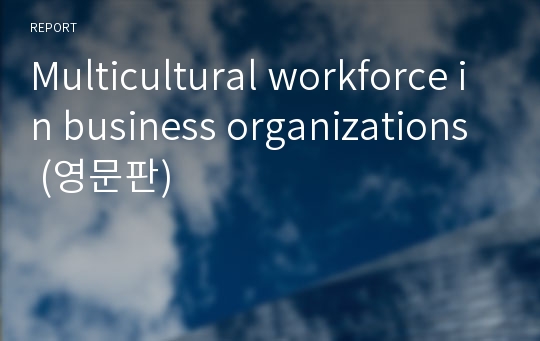Multicultural workforce in business organizations (영문판)
*덕*
다운로드
장바구니
소개글
Multicultural workforce in business organizations 에서 EXTERNAL ADAPTATION, INTERNAL INTEGRATION, LINKING ASSUMPTION 관한 영문 레포트 입니다.(MS 워드 2,464 자)
목차
1. External adaptation1.1 Relationship with nature
1.2 Nature of human activity
1.3 Nature of truth and reality
2. Internal integration
2.1 Human nature
2.2 Relationships with people
2.2.1 Importance of task versus relationships
2.2.2 Masculinity/femininity
2.2.3 Hierarchy: the role of the boss
2.2.4 Peer relations or individualism/collectivism
3. Linking assumptions: space, language, time
3.1 Space
3.2 Language
3.3 Time
4. Implication
CONCLUSION
REFERENCE
본문내용
<Introduction>Even though it is not easy to define culture because it is a highly complex
and compound concept, the best definition can be the mental software
installed inside each individual. The word ‘culture’ is derived from a Latin
word cultura meaning “to cultivate”. This is a collective concept
distinguishing members of one group from the members of another. Culture
denotes common symbols, senses, and values shared by a group of people.
Culture is not innate from birth but gradually learned with growth.
Hofstede defined culture as ‘The collective programming of the mind
which distinguishes the members of one category of people from another’.
The key expression in this definition is collective programming. (When
Cultures Collide Managing successfully across cultures p 25)
Therefore, culture can be defined as a system of shared consciousness or
frame of thought processes collectively learned by a group.
Because different cultures have different preferences, a collision is likely to
occur when two different cultures meet.
참고 자료
1. Managing across cultures by Susan C.Schneider and Jean-Louis Barsoux (pp 35 – 47)2. When Cultures Collide Managing successfully across cultures by Richard D. Lewis (pp 23 -51)
3. Managing across cultures Issues and Perspectives by Pat Joynt and Malcolm Warner (pp 33 – 55)
4. International Management Behavior Leading with a global mindset
6th Edition by Henry W. Lane , Martha L. Maznevski, Joseph J. Distefano, Joerg Dietz (pp 27 – 63)
5. International Management Managing Across Borders and Cultures
4th Edition by Helen Deresky (pp 81 – 123)
6. International management Managing in a diverse and dynamic global environment by Arvind V. Phatak , Rabi S. Bhagat , Roger J. Kashlak (pp 135 – 181)





























